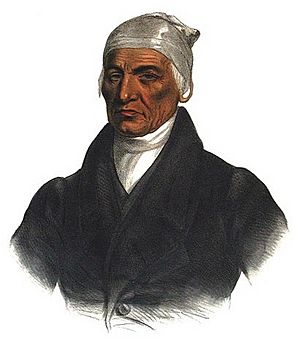Black Hoof facts for kids
Black Hoof, also known as Catecahassa, was an important leader of the Shawnee Native American people. He lived from about 1740 to 1831. Black Hoof was the main civil chief of the Shawnee in the Ohio Country, which is now part of the United States. He was known as a brave warrior in the early wars between the Shawnee and American settlers.
Contents
Black Hoof's Early Life and Battles
Black Hoof was a member of the Mekoche division of the Shawnee. He claimed he was at the Battle of the Monongahela in 1755. This battle was part of the French and Indian War. During this war, General Edward Braddock was defeated. However, there is no clear proof that Shawnees were in that battle.
We don't have many records about Black Hoof's early life before 1795. As a child, he might have been part of a group of about 400 Shawnees led by Peter Chartier. This group moved around between 1745 and 1748. They started a community in Kentucky called Eskippakithiki. Later, they moved to Sylacauga, Alabama, and then settled in Old Shawneetown, Illinois.
Black Hoof likely fought in the Battle of Point Pleasant in 1774. This battle was part of Lord Dunmore's War against the Virginia militia. During the American Revolutionary War, he might have been part of the siege of Boonesborough in 1778. This attack was led by Chief Blackfish. Black Hoof also likely helped defend the Shawnee village of Chillicothe in 1779.
In the Northwest Indian War, Black Hoof was defeated by General "Mad" Anthony Wayne. After the Native American tribes' alliance broke apart, Black Hoof gave up fighting in 1795.
Working with the United States
Like Little Turtle of the Miamis, Black Hoof believed that Native Americans needed to learn and adapt to the ways of the white settlers. He thought this would help prevent their people from being destroyed by war.
In his later years, Black Hoof became a friend and ally of the United States. He played a key role in keeping most of the Shawnee nation from joining Tecumseh's War. This war later became part of the War of 1812.
Standing Up for His People
Black Hoof strongly opposed the policy of Indian removal. This policy meant that the United States wanted to force Native American tribes to move west. He never signed any treaty that would make his people leave their lands.
Black Hoof continued to lead his tribe until he died in Saint Johns, Ohio in 1831. After his death, the Shawnee were eventually forced to move to the West.
See also
 In Spanish: Black Hoof para niños
In Spanish: Black Hoof para niños



